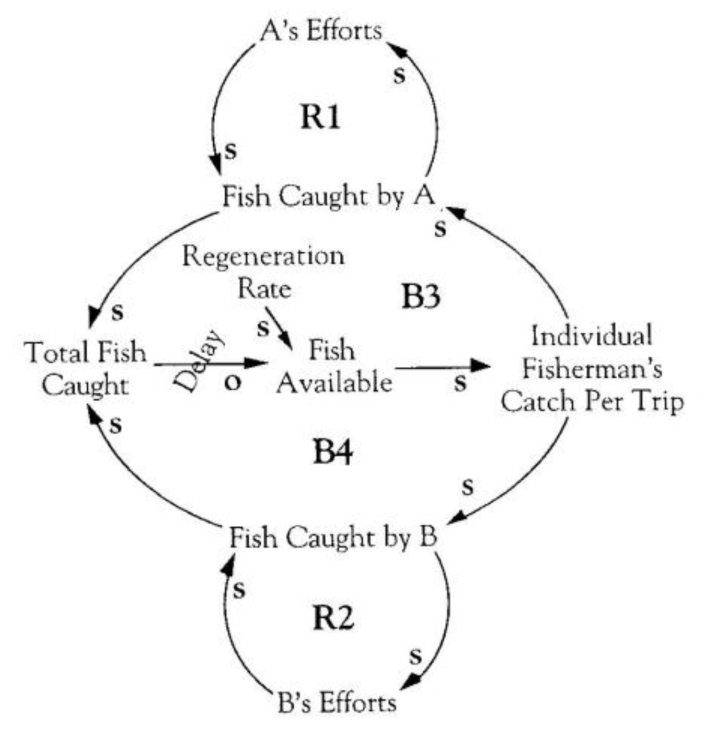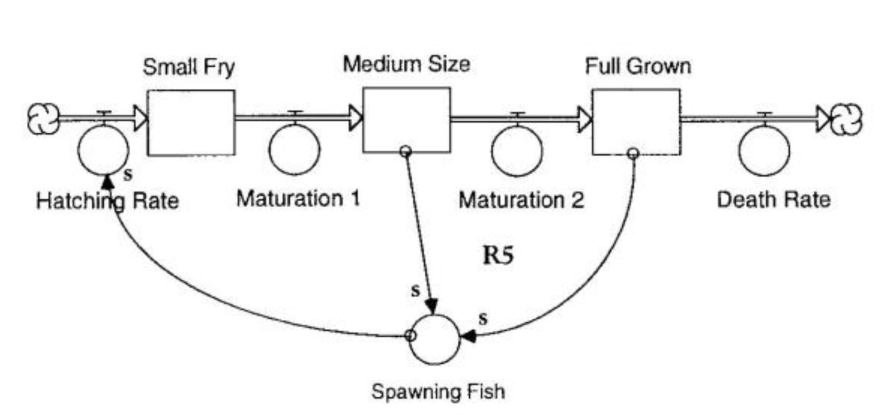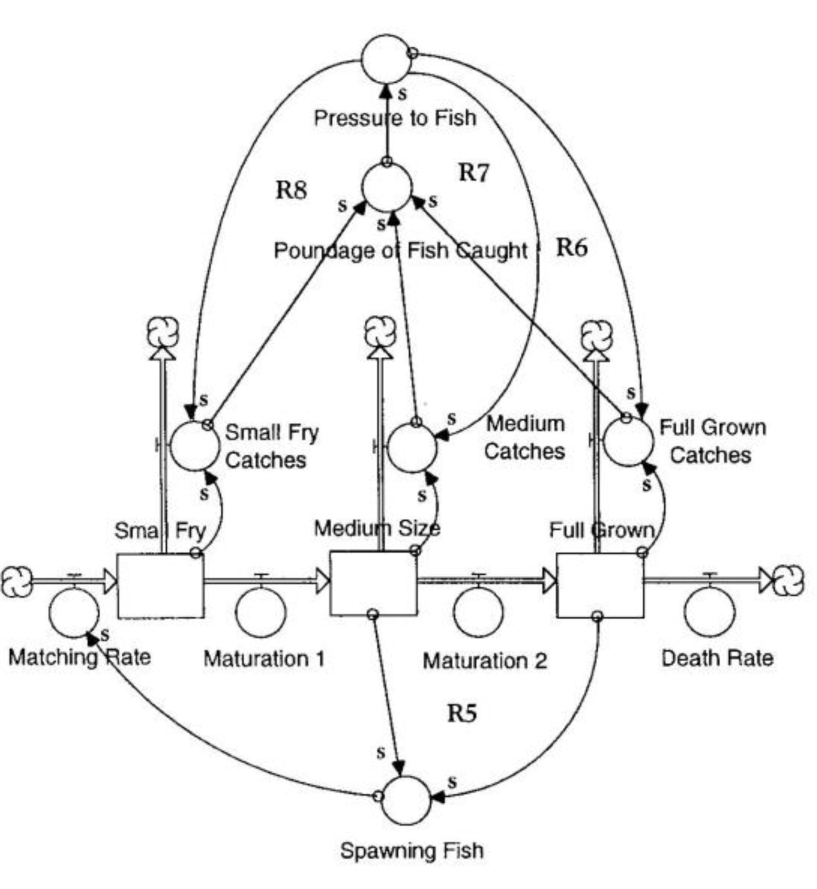Today, fully one-third of the 200 fisheries worldwide monitored by the U.N.’s Food & Agriculture Organization (FAO) are depleted or being overfished…. This view is prompting action on two fronts. Short-term, six countries agreed last year to stop pollack fishing for two years in the Bering Sea…. Meantime, governments are working to lay the foundation for better long-term management….
“The stakes are high. Worldwide, the FAO estimates, overfishing and poor management lower the optimum revenues from fishing by at least $15 billion a year. Since 1989, too many boats chasing too few fish have kept the world fleet operating at a loss, despite $54 billion in annual subsidies.” (“Not ‘So Many Fish in the Sea,’ “Business Week, July 4, 1994).
Fishing “Tragedy”

In the fishing industry, the efforts of each individual pay off in tens of larger catches (RI anti R2). However, if the catch rate exceeds the regeneration rate, fish catches will decrease even as the fishermen increase their efforts (83 and B4).
• • •
At one point in the recent movie “Forrest Gump,” Forrest, a novice shrimp boat captain, goes out for his first catch and brings back only five shrimp. “Catch one more, and you can have yourself a shrimp cocktail,” quips a more experienced captain. The audience is left to puzzle over Forrest’s ill fortune — is it the quality of his nets, his lack of experience, or his choice of fishing grounds! The answer comes in the form of a hurricane that sweeps through the area and destroys every boat except Forrest’s. Suddenly his nets are over-flowing, and he’s on his way to becoming a millionaire.
Forrest’s experience sums up the current dilemma facing the fishing industry: there is a limited number of fish (or shrimp) in the ocean, and, therefore, each individual’s success is determined to a large extent by the total number of fishermen. This storyline of multiple groups competing for a limited resource is the foundation of the “Tragedy of the Commons” archetype.
At the heart of the “Tragedy of the Commons” structure is a set of reinforcing loops representing the actions of individual players. These actions make perfect sense to each person — for example, each fisherman’s individual efforts (number of trips, investment in better nets or more boats, etc.) pay off in terms of larger catches (loops RI and R2 in “Fishing ‘Tragedy “). However, if the amount of activity grows too large for the system to support, everyone experiences diminishing benefits, even as they try harder (B3 and B4).
Managing the Commons
Managing a “Tragedy of the Commons” structure involves balancing the resource’s renewal or regeneration rate with how fast it is being depleted. In order to succeed in this balancing act, we need a better understanding of the dynamics surrounding the resource limit: how much of the resource is actually left; how fast is it being depleted; and how fast is it being regenerated? An accumulator and flow diagram can make these structural factors more explicit.
In the case of the fishing industry, the number of fish available can be described using a simple fish lifecycle: the fish hatch, and (if they do not meet an untimely demise) they mature, spawn, and eventually die. The number of new fish being hatched is determined by the number of spawning fish that are available, which is dependent on how many fish grow to maturity (R5 in “Fish Lifecycle”).
Ideally, fishing catches consist mostly of full-grown fish. However, the desired catch for fisherman is determined by overall poundage, and if there are not enough full-grown fish to make up the desired poundage (R6), the number of small- and medium-sized fish being caught will increase (R7 and R8 in “Fish Regeneration Dynamics”). This not only reduces the total fish population, but more importantly, it also depletes the stock of spawning fish. Over time, the effects of this depletion will show up in fewer hatches, which means fewer fish to mature and spawn, leading to a downward spiral in the fish population.
As the population continues to decline, fishermen are forced to go after smaller and smaller fish in order to net the total poundage desired. As Business Week explains, “Since 1960, the total catch of ocean fish and shellfish has risen 66%, to 82 million metric tons in 1992. To reach that level, fleets fish for more species and catch younger fish, which cuts the number of adults of spawning age.” If the population drops below a certain threshold level, there will not be a sufficient number of breeders available and the fish population may face total collapse.
The Dilemma of Delays
Because of the potential threat to the economies of fishing communities around the world, fisheries and governments are scrambling to salvage the nearly depleted stocks of fish. Some of the proposals, according to Business Week, include quotas for certain species, a moratorium on boat licenses, and cutbacks in the number of days that boats can spend at sea each year. To ease the financial pain these measures would cause, aid in the form of boat buy-out programs and low-interest loans to restructure debt could be implemented.
The problem with these proposals, according to some critics, is that they don’t address the underlying problem: fish stocks are being depleted faster than they are being replenished. The difficulty of managing this process lies in the long time delays inherent in the system. The number of full-grown and medium-grown fish can decline for many years before the effects show up in terms of fewer hatches and a smaller population. There is usually a critical point at which the regeneration rates drop dramatically; but by the time the total population reaches this level, there may be too few spawning fish to restock the population. The industry or government is then forced to take drastic measures, such as imposing bans on fishing.
To prevent stock depletion, the fishing industry can develop early-detection systems that will identify an impending problem before the population reaches a critical level. Lowering caps on how many pounds of fish can be caught and tightening weight restrictions might help guarantee that enough spawning fish are preserved to keep population replenishment consistent. If the population is managed more efficiently, not only will the fish population and ocean ecosystems be protected, but the financial success of the industry as a whole will be optimized. Instead of having to face oscillating stocks of fish and the financial uncertainty that comes with such a dynamic, fishermen could expect more stability over time.
Organizational “Commons”
This type of crisis is not unique to the fishing industry. Companies with a centralized sales force, engineering department, or maintenance function can experience similar dynamics. As each division requests more efforts on its behalf, the central resource’s ability to service all of its customers goes down. In this case, usually an implicit or explicit limit is keeping the resource constrained at a specific level.
Although the setting may be different, the lesson is the same: when managing a common resource, it is important to consider the whole system. There will always be a struggle to maintain the right balance between acquisitions and depletions, and early detection signals are necessary to catch potential problems before individual actions over-whelm the system. In a “Tragedy of the Commons” scenario, it is critical to remember that policies aimed at specific parties or behaviors will not be sufficient to counter the reinforcing actions that are played out over time. Just as a hurricane can hardly be expected to wipe out the other players currently using our shared resource, it won’t be long before Forrest Gump sees other boats on the horizon. Other resources: The Fishbanks Game, do Karen Burnett-Kurie, University of New Hampshire, (603) 862-2186.
Fish Lifecycle

Fish Regeneration Dynamics

